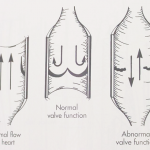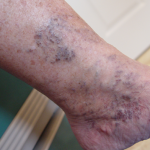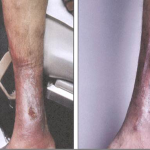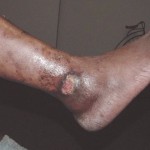Whether you have Obvious or Subtle Signs and Symptoms, Untreated Vein Diseases can Have Serious Consequences
Venous System
The venous system is designed to return blood back to the heart where it picks up a fresh supply of oxygen and is pumped through a pressurized arterial system to organs and tissues of the body. Two venous systems in the legs move blood towards the heart through compression of leg veins resulting from contraction of leg muscles. In a normal state, valves in the veins keep blood flowing in a single direction towards the heart and prevent blood from flowing backwards into leg veins.
Venous Disease
Diseases of the veins include spider veins, varicose veins, chronic venous insufficiency and venous leg ulcers. These are due to incompetent valves in veins that are designed to move blood forward towards the heart. Whether in the superficial or deeper veins, incompetent valves produce a reversal in vein blood flow, moving blood back towards the feet when the legs are at rest. The inability of the venous system to drain properly produces increased blood pressure (venous hypertension) in the affected blood vessels that expand or dilate to accommodate the enlarged blood volume.
Signs and Symptoms
One of the first signs of venous disease is the development of spider veins and varicose veins in the legs. Patients generally complain of difficulty standing on their feet, a poor exercise tolerance and difficulty sleeping. Restless legs and itchy leg skin can be less obvious signs of venous disease. Aching leg pain, night cramps and unusual sensations on the legs occur when distended larger veins put pressure on nerves. With progression of vein disease, increased venous pressure and stasis causes swelling or edema and often a brownish skin discoloration called hemosiderosis. Venous congestion also compromises cellular exchange of oxygen, nutrients and wastes in the capillary beds. The tissues of the leg respond first by thickening and finally by dying. The ultimate consequence of vein disease is a venous stasis leg ulcer with infection of the surrounding skin called cellulitis.
Spider Veins
Spider veins are bright red to blue thread-like veins that may develop on the legs as well as face and neck. Sometimes called thread veins, spider veins occur from abnormal venous blood flow with associated increased pressure in these tiny vessels. This causes them to dilate and become prominent. Spider veins are generally a cosmetic concern but may be one of the earliest signs of venous disease.
Varicose Veins
Malfunctioning valves in superficial leg veins can reverse normal vein flow back to the heart. As vein flow is compromised, blood leaks backwards towards the feet. The result is restricted venous drainage, increased venous pressure and the development of twisted, distended varicose veins. Varicose veins affect larger surface veins in the legs with the primary areas of venous incompetence involving the Greater Saphenous Vein on the inside of the thigh and calf, the Small Saphenous Vein on the back of the calf and the Perforator veins of the calf.
Chronic Venous Insufficiency
Chronic venous insufficiency or CVI represents a severe venous stasis disorder originating from incompetent valves in major superficial and deep leg veins. As venous congestion worsens from a reversal in blood flow, pressure increases and produces a cluster of symptoms collectively called CVI. Symptoms often include leg pain, night cramps and unusual sensations on the legs, swelling or edema, skin thickening and brownish skin discoloration called hemosiderosis. Commonly associated venous disorders are spider veins, varicose veins, venous stasis leg ulcers and cellulitis, a severe infection of the tissue surrounding an ulcer.
Venous Leg Ulcers
A severe consequence of chronic venous insufficiency or CVI syndrome, venous stasis leg ulcers result from prolonged and extensive venous congestion and hypertension in leg veins. Impaired exchange of oxygen and nutrients with cellular wastes at the capillary level leads to skin discoloration, thickening and ulcers of the lower legs. Almost always, venous stasis leg ulcers are caused by incompetent perforator veins in the calf.
Common Vein Treatment Questions
Why should I be evaluated and treated for diseases of the veins?
What can I expect during my initial appointment?
What can I expect during and following my vein treatment procedure?
Who should be evaluated for diseases of the veins?
How can I get a vein screening exam?
More About Vein Treatment and VSA…
Get in touch with VSA
State-of-the-Art Vein Treatment
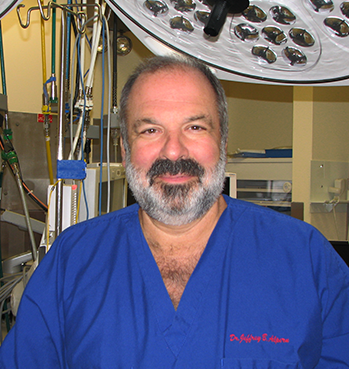 You are one step away from the most effective, technologically advanced procedures for the safe and virtually painless treatment of spider veins, varicose veins, venous leg ulcers and chronic venous insufficiency. These state-of-the-art aesthetic and medical procedures are fast, comfortable, without side effects, associated with a rapid recovery, and performed in the office while you remain awake. Procedures for the treatment of venous disease are generally covered by insurance and Medicare.
You are one step away from the most effective, technologically advanced procedures for the safe and virtually painless treatment of spider veins, varicose veins, venous leg ulcers and chronic venous insufficiency. These state-of-the-art aesthetic and medical procedures are fast, comfortable, without side effects, associated with a rapid recovery, and performed in the office while you remain awake. Procedures for the treatment of venous disease are generally covered by insurance and Medicare.
Vein Specialists of Arizona is conveniently located in Phoenix close to Anthem, Avondale, Buckeye, Camp Verde, Casa Grande, Cave Creek, Chandler, Cottonwood, Flagstaff, Gilbert, Glendale, Goodyear, Kingman, Lake Havasu City, Lakeside, Maryville, Mesa, Peoria, Prescott, Prescott Valley, Scottsdale, Sierra Vista, Sun City, Sun City West, Surprise, Tempe, Tucson and Yuma.




